#guidance scale 5
Note
hey frank! can you draw me a gay guy pride flag?
I did a quick one here:

536 notes
·
View notes
Text
on authenticity
My mood in the recent months keeps going from bad to worse. Today I randomly fell into the rabbit hole of checking out other patreon artists, which always grounds me in reality and cheers me up, perhaps in a weird way. Essay incoming \o/
Authenticity is a blob of a word that sounds almost pretentious nowadays. It gets sneered at. You either sell your soul, or you don't earn with your art.
What's authentic, being true to yourself, will vary from person to person. It's like a sliding scale of suffering that you will tolerate in exchange for a coin, while convincing yourself that you have fun.
The harsh truth of modern world is that if your art pays for your living, you've already reached success, no matter how you may feel about the type of content you actually make for that money. Insert the meme furry nsfw art here. Or not furry. Or even sfw, but comms, lots of comms every month. Or merch. Anything that sells. Products first, art second.
Marrying passion and profession is virtually impossible, yet I'm doing it, only thanks to your support. I'm acutely aware that, even as I choose to be "real" and talk about an artist's money-making in a raw way, it's still patreon talk, and yes, I'll plug the link as well, so technically this entire post is an ad *fingerguns*
I just feel so privileged being able to create whatever the fuck I want, literally, I take no comms/requests/guidance on what and how should I draw/write, I post experimental, sometimes provocative stuff, and still make enough to survive. This sole fact should get me through the day, whatever other struggles I may be facing currently (I am. I don't wanna talk about it rn, instead I distract myself with this text), I should always remember the unique place in life I managed to carve for myself.
There are madmen (gender-neutral) who toss $10-20 at me every month. The majority "only" pledges $1, the notorious tier that gets treated as a tip jar with no rewards by many other creators. All of my rewards are the same at $1 and $20 (save for the one-time digital artbook download at $10, just to be perfectly clear), it's a conscious choice and a risk I continue taking because it's how I am. I used to split rewards between tiers in the past, before xiv, and it was a lot of busy work while it made me treat my art less as art and more as product. This pic goes into the cheap box, this pic goes into the expensive box. Every month. It's. Definitely not for every artist.
Logistic hell of splitting and delivering rewards, different posts with less comments per post, also my discord roles/channels would have to be split, nowadays it's just patron, whether you give me $1 or $20, there's no visual disparity, you're hanging out in the same cool kids' club, and collectively making happy noises on Fragments Fridays.
Could I be making more money if I got rid of the $1 tier? Yeah. But, mercifully, after 2 years I don't need to. I legit make enough currently, my only worry is to keep what I have. Patrons don't stay forever, 2-5 people would leave every month, about the same number would join (hence my patreon ads, I need to keep people reminded of it, even if it makes me feel guilty every damn time). I did Research (tm) in the past to find out that my "bleeding" numbers are below average, i.e. it's good, people generally tend to stick around.
I put a lot of emphasis on the $1 because I'm kinda proud of what I managed to accomplish while staying self-detrimentally humble. Literally doing an impossible thing in a world that keeps burning down. So yeah if you've been feeling bad for only giving me $1, what matters is that there's enough $1s to make a difference. Together you're creating a phenomenon, and you should be proud.
There are many stupid little principles, hills that I'll die on, that make up my authenticity. I chose to speak of it here and now in order to sorta sell myself, so it feels hypocritical x'D But if I don't shine a spotlight on this, who will. I'm old and jaded and increasingly terrified of how insincere the internet's becoming. Everything's fake, sugarcoated, polished for sale. My art's always been a scream of defiance against all that, now that I'm more or less established, I wanna scream louder. Thanks for hearing my screams. You can scream with me too if you want.
71 notes
·
View notes
Text

8: ZODIAC CONSTELLATIONS
The ancient Greek Zodiakos, or Zodiac, is a division of the celestial sphere into twelve equal parts; each one containing a specific group of stars with a mythic association called a constellation. Ancient Greeks used the constellations for sailing navigation, time keeping for seasonal agricultural practices like planting and harvesting crops, mythic storytelling purposes, and astrology practices.
Hellenistic Astrology, taking influence from the Babylonians and Egyptians, sought meaning in the zodiac signs and how they influenced a person’s character based on the position of the sun when they were born. They also used this practice for divination, providing guidance and predictions for the future. Let’s take a look at the twelve Zodiac constellations and their mythic tales.
1.) Aries (March 21-April 19) represents the flying golden ram sent by the gods to save the royal children Phrixus and Helle from sacrifice, and whose fleece later becomes the quested prize for the Argonauts.
2.) Taurus (April 20-May 20) represents the bull which Zeus transformed into to seduce Europa, and is linked to the Cretan Bull and the myth of the Minotaur.
3.) Gemini (May 21-June 21) represents the twins Castor and Pollux, sons of Zeus and Leda, known for their inseparable bond and heroic deeds.
4.) Cancer (June 22- July 22) represents the crab sent by Hera to distract Hercules during his battle with the Hydra, later placed in the sky by Hera as a constellation.
5.) Leo (July 23- Aug. 22) represents the lion, representing strength and kingship, associated with the Nemean Lion defeated by Hercules.
6.) Virgo (Aug 23- Sept 22) represents the maiden, often linked to the goddess of agriculture and fertility, such as Demeter or Persephone.
7.) Libra (Sept 23- Oct 23) represents goddess of justice Astraea, daughter of Themis, who carries the scales of justice.
8.) Scorpio (Oct 24- Nov 21) represents the scorpion sent by Artemis or Gaia to kill Orion
9.) Sagittarius (Nov 22- Dec 21) represents the centaur archer, often identified as the wise and skilled Chiron.
10.) Capricorn (Dec 22- Jan 19) represents the sea goat Aegipan, who aided Zeus in his fight against Typhon.
11.) Aquarius (Jan 20- Feb 18) represents the cupbearer of the gods, Ganymede, who was abducted by Zeus and placed among the stars.
12.) Pisces (Feb 19- March 20) represents the two fish, Aphrodite and Eros, who transformed to escape the monster Typhon.
Like this art? It will be in my illustrated book with over 130 other full page illustrations coming in June to kickstarter. to get unseen free hi-hes art subscribe to my email newsletter
Follow my backerkit kickstarter notification page.
Thank you for supporting independent artists! 🤘❤️🏛😁
#greekmythology#greekgods#pjo#mythology#classics#classicscommunity#myths#ancientgreece#zodiac#greekzodiac
60 notes
·
View notes
Text
Yor's Cooking
So I've been discussing about why Yor's cooking is unconventional, and why she struggles with ‘home/domestic cooking’ with @rachellysebrook and @letthebodyfall
It’s because Yor is so used to ‘Survival Cooking’!!
We came up with this reasons:
(long post)
In this Yuri's ramblings at the cover of vol 5, amidst the cringey stuff, we can find interesting information:

I already explored several of my HCs regarding the Briar's hometown and past experiences in my fic, such as:
Nielsberg might be located at the south east part of Ostania, near mountain places (south east of Germany is indeed has more mountains, if we googled.) Eastern Nielsberg, the Briar’s house, might located at the sub rural, places where civilization were even more scarce. It was far from the war front places, but at the same time, food and other supplies might be also scarce.
Which was why, when the Briar siblings lost their parent, they choose to hunt for their food. With Yor’s inhuman strength that she already possessed, they did manage to catch animal to survive.
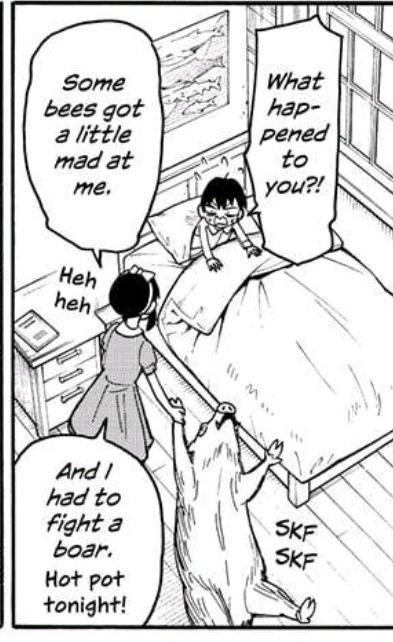
Maybe at one time, Yor also thought that the bigger animal equals to better nutrition XD leading her trying to fight a bear. Maybe....
Anyway, without the proper guidance from the adults at that time, we also hc that the Briar siblings learnt things by doing how to:
Prepare the animal carcass, including cooking the meat to the point of overcook in order to avoid germ/poisoning
Making survival tents during their hunting periods
Preserve foods, always tried to use every single part of the animal and not waste anything: scales, bones, fins, heads, etc.

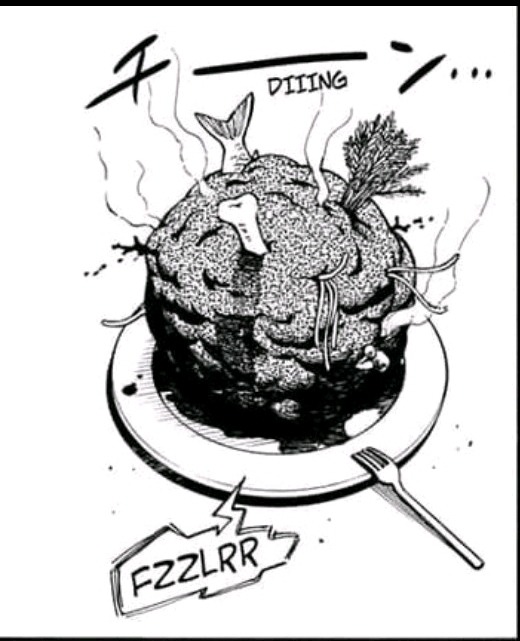

They are so used to hunt for food, Yor is still confused at the convenience of being able to buy them at the groceries:
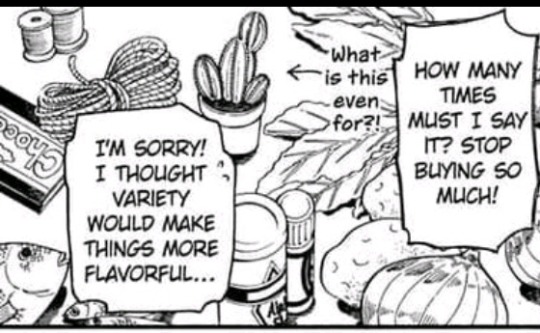
Making her buying everything available including: Ropes and threads (for making tents and fishing, or making traps), and cacti (several type of cacti is actually edible).
Other than ingredients, spices were most likely very scarce too! Which make Yor not accustomed to use them. Salt in particular, can be very difficult to obtain in mountains, especially in such a rural area during war.
So, all in all, Yor’s is so accustomed to Survival Cooking, that the most important thing she has to gain is the nutrition and not the ‘taste’.
That’s why Yuri said that her food has certain ‘full bodied aroma’ in it, and Yor herself thought that ‘as long as the nutrients are there, it’s enough’.
Btw, Loid can stand Yor’s cooking because he was a soldier himself. Soldiers, especially ones that stays at the front lines, are used to survival rations that well.... taste like sh*t, but of course they wouldn’t care. Because survival comes first.
Anya, Camilla, and Dominic aren’t soldiers, so it’s understandable that they have lower resistance ^^;
These reasons plus the idea that the Forgers has just been together for 3 months, of course Yor hasn’t been able to improve her home cooking just yet. But she’s getting there.
Cause unlike before, now she has family to feed as motivation (as seen in chp 24), and has good teacher (Loid and maybe Camilla to a certain point) that will teach her patiently.
One day, her cooking will improve.
771 notes
·
View notes
Text
From the Inquisitor to the Baptist: The Evolution of John Seed

When Far Cry 5 came out, on March 27, 2018, players got to finally meet John Seed “in person” and see his final design. That said, it’s still possible to stumble upon early versions of him in the game and its files.
All the sources and references indicated by the superscript numbers will be given in the last post.
Part 2: Physical appearance, clothes, and tattoos (Far Cry 5)
Here is John Seed, the Baptist, as he appears in Far Cry 5 most of the time:



His coat is now decorated with planes, but it still has scales on the buttons. He has a two-tone blue shirt, a vest (it seems, heavily inspired by a piece from the D&G Spring/Summer 2010 menswear collection²⁷), dark grey jeans with a brown belt and an “EG” belt buckle, dark grey, laced, probably leather boots, a watch, an Eden’s Gate earring, blue sunglasses (on his head), his bunker key around his neck, a SLOTH scar on his chest, and a lot of tattoos²⁸:

Among them, in addition to the ones previously mentioned in Part 1 (the letters and symbols on his fingers, the goat, the snake, the flames, the scales, and the angelic figure with the dove in the wreath), we find:
On his right arm,
a nautical star (can represent guidance) and diamonds/jewels (can represent beauty and power)
the number seven in tally marks (also tattooed on his left little finger), probably for the seven deadly sins
a fly (can represent determination)
a sword/dagger (can represent protection or sacrifice)
an anchor (can represent God and groundedness) with another snake and pair of scales
a crescent moon (can represent purity or transition, a new beginning)
a peacock feather (the peacock is used to symbolize Pride)
the word SLOTH crossed out
a flaming horseshoe, possibly to symbolize the Horsemen (and fire) of the Apocalypse.
On his left arm,
a revolver, maybe the last vestige of the gun he was holding in the first promotional pictures and in Absolution
an eagle, which looks like it’s about to catch the snake, maybe to symbolize Eden’s Gate (the cult used to be represented by an eagle, as seen in the early piece of concept art of the Seed family¹), “killing” sins (here, Envy)
an ax (can represent strength and fearlessness)
the plane pattern that is now also on his coat
a religious cross
a chair and the words “SIT DOWN & WE TALK”, most likely a reference to the fact he’s the Project’s Confessor
a holy figure with a sickle attached to their hand and what looks like sprigs of wheat, the latter probably symbolizing the Reaping and the fact John is in charge of it
another cross with “EG” in the middle, as well as the Greek letters alpha (A) and omega (ω), “the beginning and the end” in the Book of Revelation in the Bible
a bird, maybe a swallow (can represent freedom and resilience).
Most of his tattoos seem to be religious symbols, but depending on who you ask, tattoos can have very different, sometimes deeply personal meanings, so it’s difficult to know exactly what they’re supposed to represent. Some of the significations I’ve just mentioned in the list are very generic and can be found on many websites.
The crossed-out word SLOTH is particularly interesting to me because John has a similar scar on his chest, and “Acedia” (Sloth) is missing from the list tattooed on his left hand. It seems he really hates this sin²⁹…
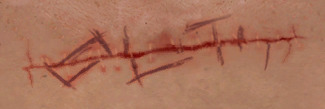
But funnily enough, in the game, John doesn’t always look like this.
In the bedroom of the Holmes Residence, on Joseph’s Island, there are pictures of the Seed family on the wall, and John appears in two of them³⁰:

In the first one, he’s wearing his sunglasses, and his coat appears to have EG logos on it instead of planes. In the other picture, his coat might also be the “old” one, but it’s hard to tell.
In the family portrait, also visible in the Holmes Residence³¹, it’s his early character model (no glasses, no tattoos, “EG” pattern on the coat), the one we see in the Prima Games guide, who is in the picture. His siblings look slightly different as well.
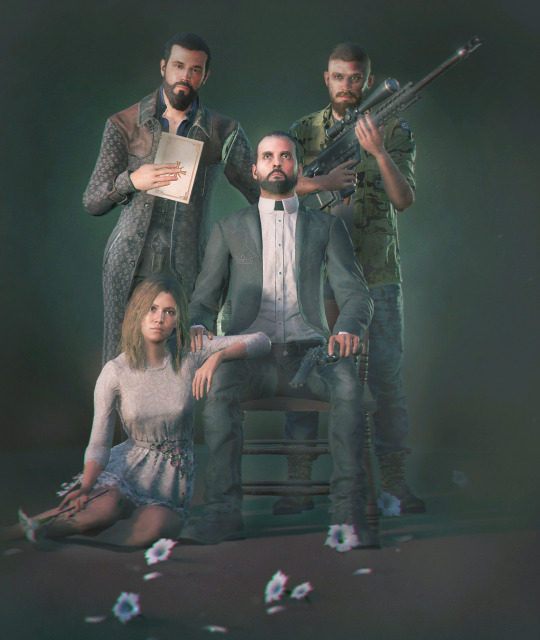
In Dutch’s bunker, there also are pictures (and short descriptions) of the Father and his Heralds. Once again, it’s John’s early model who seems to be in the photo³².

In the “Power of Yes” poster, he’s wearing his sunglasses³²:

On the “We love you and we will take you” billboards³², John’s picture is a mixture of several designs. His coat is the final one, with planes, but his face appears to belong to his early model because his sunglasses are nowhere to be found and I think his beard looks slightly longer. He has the SLOTH scar and bunker key, but the letters on his fingers are S, G, and G for Sloth and Gluttony/Greed. The tattoo on his hand is hard to see, but it doesn’t seem to be the nautical star and diamonds.
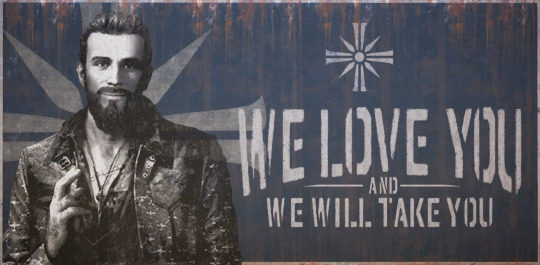
In the menu, more specifically in the Journal, where missions are listed, we can once again see John’s early model (no glasses, no tattoos), like in this image that illustrates the mission “The Confession”³³:

I’ve previously mentioned an early version of the “You have been Marked” broadcast (in IGN’s video²¹), but an even earlier version of it can be seen in Far Cry Arcade. If you add the “Counter Cafeteria” (Far Cry 5 > Objects > Residential > Kitchen) to your map in the Arcade Editor, you can see this³⁴:
The Eden’s Gate cross that appears at the beginning is also a very early design, the one featured in what could be the first artwork of the Seed family¹.
A picture of John’s old 3D model was also in the deleted in-game encyclopedia (still partially available in the files)³⁵. His sunglasses, key, scar, and tattoos are missing, and he has the EG coat.

In the loading screens for the Holland Valley region, although John looks a little more realistic than his in-game model, his design appears to be the same³⁶:
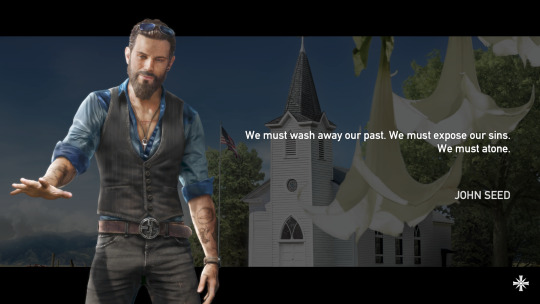
As for his in-game portrait and character icon, they feature his final design as well:

But there also exists a very early version of this portrait in the files. John appears to be the character on the left, once again wearing sunglasses³⁷:
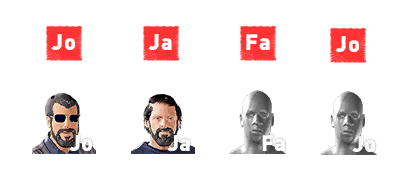
But surprisingly, the release of Far Cry 5 didn’t mark the end of the changes regarding John’s appearance. After the game came out, his model was slightly altered one last time.
If you ever took a close look at his shoes in the first few months that followed the release of Far Cry 5, you may have noticed that there was blood on them. This blood stain is also visible in the “Four Horsemen of the Apocalypse” official artwork²³:

But when I looked at his shoes again in the Arcade Editor five months later, the blood was mysteriously gone…

I have no idea why it was removed, but I like that it was because John’s evolution, from the game’s earliest stages of development to its final version, was not just physical; his personality, methods, and morals were also modified. The blood disappearing from his shoes is a subtle and maybe meaningless change, but I think it perfectly illustrates how his violence was gradually toned down during the development of Far Cry 5.
To be continued…
98 notes
·
View notes
Text
Kaiju Weeks in Review (March 31-April 13, 2024)
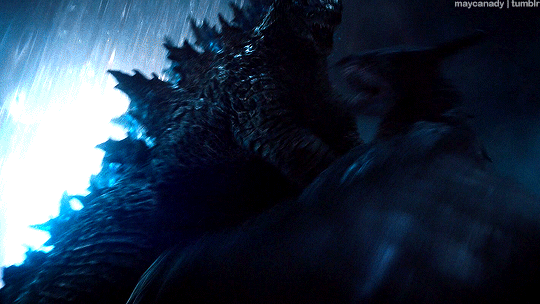
It took forever (maybe they were waiting on the returns for Godzilla x Kong), but Apple TV+ has finally greenlit season 2 of Monarch: Legacy of Monsters. According to its listing on the WGA site, it'll run from 2024 to 2025. Multiple spinoffs are also in development at Apple; no details on those yet.
Speaking of Godzilla x Kong, it continues to do well, staying #1 at the domestic box office in its second weekend and falling to #2 (behind Civil War) in its third. Current totals are $158 million domestic and $437 million worldwide. It'll soon pass the domestic gross of Kong: Skull Island and the total gross of Godzilla vs. Kong.

Godzilla vs. The Mighty Morphin Power Rangers II #1 promises more of everything: more heroes (the White Ranger joins our heroes from the first comic), more villains (including Psycho Ranger Ghidora up there), and more alternate universes. Godzilla gets a bit buried in all the Ranger antics though.

A couple of kaiju series debuted on TV too: Kaiju No. 8 and Season 2 of Chibi Godzilla Raids Again. The former followed the manga very closely, and as such didn't really keep my attention; hopefully it innovates a bit more going forward. Chibi Godzilla's as irreverent as ever.
youtube
Tsuburaya Productions has released preliminary information on the next installment of the Ultra Series, Ultraman Arc. The logline:
A town called Hoshimoto City...
On Mt. Shishio, there is a gigantic object towering above the city. Named "Monohorn," (モノホーン, Monohōn) it is actually a kaiju’s horn stuck in the ground since an incident 16 years ago.
After the incident known as "K-DAY" in which kaiju appeared all over the world at the same time, monster disasters have become commonplace. In Japan, the Global Defense Force (GDF) uses force to deal with them, while SKIP works closely with the community in scientific investigations and evacuation guidance to prevent the occurrence and aggravation of kaiju disasters. SKIP has also been investigating the Monohorn, the horn of the galactic beast Monogelos (モノゲロス, Monogerosu) that appeared on K-DAY.
Yuma, then only 7 years old, was camping with his parents in Mt. Shishio when Monogelos attacked. After miraculously surviving unscathed, he decided to pursue research into monster biology. Despite his traumatic past, he has not lost his “power of imagination” to dream. As a rookie investigator, Yuma joined SKIP and was assigned to the Hoshimoto City Branch.
Not long after, another large-scale monster disaster occurs in Hoshimoto City. As Yuma sees the desperate people in front of him, a strong will springs into his mind — “I want to protect them!” At the moment when this strong and straightforward desire welled up from the bottom of his heart, Yuma hears the voice of Rution (ルティオン, Rution) a being of light that he once saw as a child:
“You and I are one and the same… Unleash your imagination!”
When a mysterious light appears in Yuma's hand and envelops his body, the unleashed power of imagination unites light and man and he transforms into Ultraman Arc, the Giant of Light who protects the future! Alongside his precious friends, Yuma, as well as Ultraman Arc, races towards his everlasting dream!
Yuma is played by Yuki Totsuka, while Takanori Tsujimoto is the lead director. He's directed for the series since Ultraman X, but this is his biggest assignment to date.

After beginning to release select Movie Monster Series figures in the States, Bandai America is now fully back in the Godzilla game, with articulated figures, 5-inch vinyls, blind box figures, and transforming eggs all up for preorder at the Godzilla Store and other toy sites. The eggs come from the 2014 Godzilla-E.G. line and the rest is all-new. Not much of a selection so far, but with how big Godzilla is right now, I'm sure there'll be more to come.
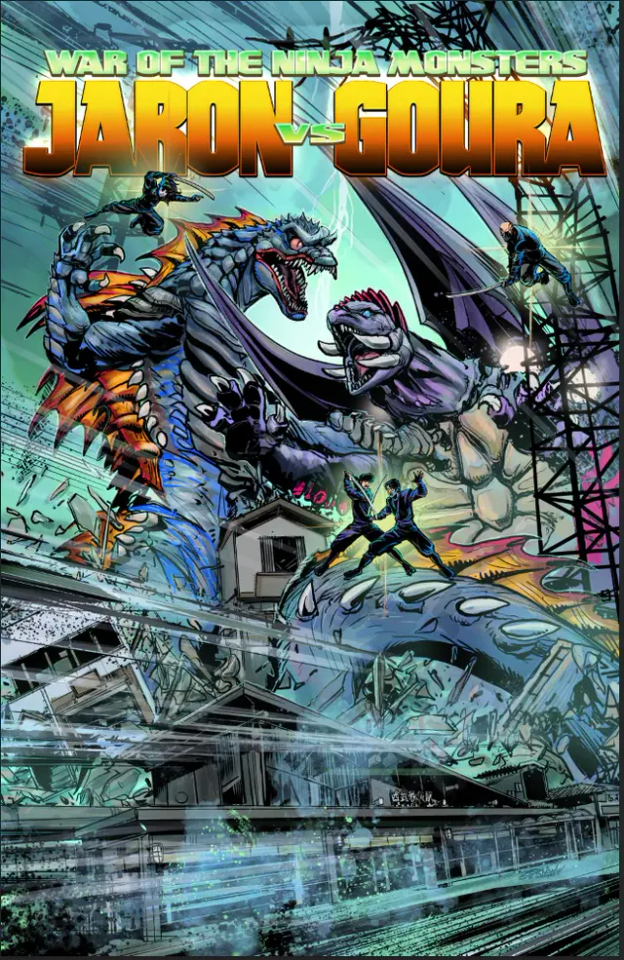
SRS Cinema has opened preorders for its War of the Ninja Monsters: Jaron vs. Goura Blu-ray, due in late July or August. Shinpei Hayashiya's latest epic, it'll come with behind-the-scenes footage and maybe a commentary track, which would be nice given how little information is available about his films online.
#kaiju week in review#godzilla#monarch legacy of monsters#war of the ninja monsters jaron vs. goura#toys#ultraman arc#Youtube
34 notes
·
View notes
Text
Witch Engine (Monster)

(Witch Engine by Kev Walker)
(Hey, I'm back for the time being! Sorry about my unannounced, impromptu hiatus- the simple fact is I live with ADHD, and my attention tends to wander. This is an attempt to get myself back on track, but I make no promises.
As for the witch engine herself- what an iconic creature! They've only got the one card, but they appear in the background of art in cards to represent Phyrexia's spread. With such a great design and a great name, I HAD to make these important to my Phyrexia.)
Witch engines are the hands of phyrexia, overseeing much of its ingress into other worlds directly. Indeed, most worlds touched by Phyrexia will know witch engines as the highest power therein, as a trio of these artificial horrors can orchestrate a planetary-scale infiltration and invasion with minimal guidance. But a witch engine is more than just a leader; she is a deadly weapon, capable of shredding through armies with a combination of necrotic magic and her own deadly whirling claws.
Because witch engines are required to organize a phyrexian assault and react to new planets' unique challenges, they are among the most independent and intelligent of phyrexians- each witch engine has its own personality matrix, with different engines being more cautious, curious, or patient than others. Each planetary invasion force is led by three such differing personalities, and each takes the others' opinion- as well as information from the current invasion- to arrive at the best plan of attack.
A witch engine typically keeps a skirge as a familiar, although other familiars with the Phyrexian template are not unheard of.

(Contamination by Stephen Daniele)
This wretched creature stands on two spindly legs with reversed knees; its arms are equally long and tipped with swordlike claws, and its vulturine head scours the area with wicked brilliance
Misc- CR18 NE Huge Aberration HD27 Init:+5 Senses: Perception: Darkvision 90ft, Lifesense 60ft Aura:
Stats- Str:24(+7) Dex:21(+5) Con:17(+3) Int:28(+9) Wis:25(+7) Cha:22(+6) BAB:+20/+15/+10/+5 Space:15ft Reach:15ft
Defense- HP:203(27d8+81) AC:34(-2 Size, +5 Dex, +9 Deflection, +12 Natural) Fort:+12 Ref:+14 Will:+22 CMD:44 Resist: Cold 20, Fire 20, Electricity 20 Immunity: Acid, Fear, Curse, Polymorph, Petrification, Death effects, Disease, Poison Weakness: Special Defenses: Hexshield, SR29, DR10/Adamantine and Good, Fast Healing 10, Negative Energy Affinity
Offense- Bite +23(2d8+7) 2 Claw +23(2d6+7/18-20x3) CMB:+29 Speed:40ft, Fly 60ft (Perfect, Supernatural) Special Attacks: Sneak Attack +5d6, Ghastly Rend, Flensing Claws
Feats- Spell Focus (Necromancy), Power Attack (-5/+10), Multiattack, Accursed Hex, Quicken Spell, Improved Familiar, Combat Casting, Improved Bull Rush, Awesome Blow, Critical Focus, Crippling Critical, Blinding Critical, Quicken Spell-Like Ability (Greater Dispel Magic)
Skills- Appraise +29, Climb +15, Disable Device +25, Fly +21, Knowledge (Arcana) +33, Knowledge (Engineering) +26, Knowledge (Local) +29, Knowledge (Nature) +33, Knowledge (Planes) +33, Knowledge (Religion) +33, Linguistics +26, Perception +37, Sense Motive +27, Spellcraft +36, Stealth -3, Swim +15, Use Magic Device +26
Spell-like Abilities- (Caster Level 19, +25 Concentration, +29 from Combat)
Fly, Tongues /constant
Animate Dead, Contagion, Greater Dispel Magic, Inflict Critical Wounds (DC22) /at-will
Create Undead, Curse Terrain, Flesh Wall (DC22), Quickened Greater Dispel Magic, Mass Inflict Serious Wounds (DC24), Plague Storm (DC22) 3/day
Spells- (Caster Level 16, +25 Concentration, +29 from Combat)
8 (2+1, DC25)- Horrid Wilting, Supreme Curse Terrain, Irresistible Dance
7 (3+1, DC24)- Mass Inflict Moderate Wounds, Mass Hunger for Flesh, Quickened Dimension Door, Waves of Exhaustion
6 (3+1, DC23)- Quickened Dispel Magic, Symbol of Fear, True Seeing, Eyebite
5 (4+1, DC22)- Break Enchantment, Dominate Person, Suffocation, Symbol of Pain, Waves of Fatigue
4 (4+2, DC21)- Black Tentacles, Dimension Door, Inflict Serious Wounds, Insect Spies, Solid Fog
3 (4+2, DC20)- Bestow Curse, Contagion, Lightning Bolt, Suggestion, Vermin Shape I
2 (4+2, DC19)- Alter Self, Detect Thoughts, Inflict Moderate Wounds, Paranoia, See Invisibility, Status
1 (4+3, DC18)- Command, Charm Person, Long Arm, Obscuring Mist, Ray of Enfeeblement, Unseen Servant, Web Bolt
Special Qualities- Spells, Hexes (DC27, Evil Eye, Cackle, Scar, Misfortune, Slumber, Agony, Pariah, Hag’s Eye), Familiar (Skirge)
Ecology- Environment- Any Languages- Necril, Common, Aklo, Infernal, Abyssal, Draconic, Dwarven, Undercommon Organization- Solitary, Coven (3), Army (1 Witch Engine, 1 Negator, 1 Slaughterwurm, 8-16 Ragers, 0-4 Vatmothers, 15-20 Plague Spitters, 20-30 Mortis Hounds) Treasure- Double (5th lv Pearl of Power)
Special Abilities- Flensing Claws (Ex)- A witch engine’s claws are perfectly engineered to strip flesh; they deal x3 damage on a critical hit and have a threat range of 18-20. Ghastly Rend (Ex)- If it hits with two or more claw attacks against one creature in one round, a witch engine latches on and precisely vivisects the target. It chooses Strength, Dexterity, or Constitution and deals 10 damage of the chosen type to that creature. Hexes (Su)- A witch engine has hexes as a level 16 witch. Hexshield (Su)- A witch engine adds its intelligence bonus to its AC as a deflection bonus. Spells (Su)- A Witch engine casts spells as a 16th level Witch. She does not gain Patron spells.
47 notes
·
View notes
Text
Dogai

Image © @chimeride, accessed at their tumblr here
[The dogai are the archetypal monster in the lore of the Torres Straits. Unfortunately, they have a lot of Google camouflage. The assassin devil from D&D 3.5 and 4e is also called the "dogai". I have no idea if this is an intentional reference, or if it's a coincidence due to how many short combinations of syllables sound good. Like a lot of good ogres, they vacillate between dangerous and stupid, so I didn't want them to be super powerful. The appearance of the image comes from Oceanic Mythology by Roland Dixon, which refers to dogai as having the face of a flying fox.]
Dogai
CR 4 CE Monstrous Humanoid
This creature is a bestial humanoid, with a furry body and spindly, scaled arms and legs. Its face has a long muzzle and staring eyes, and its ears are as large as its body, wrapped around it like a shawl.
The dogai are bestial hags native to tropical islands. They are of low intelligence—few of them can speak Common, and they are rather foolish and easily tricked. Still, they are malicious and dangerous as any hag, and engage in much the same behavior as other hags, such as seducing people in disguise and kidnapping children in order to eat them.
A dogai often attacks from ambush, assuming the form of a beautiful woman or a harmless animal in order to get close enough to strike. These disguises are supplemented with mimicked vocalizations, including short snatches of intelligible speech. Once in combat, they rarely use tactics more creative than full attacks, but if they have a hard time clawing or biting a foe, may lash out with magic. Dogai are cowardly, and usually try to flee if they are losing a fight.
Dogai tend to live on remote islands uninhabited by other humanoids, and then travel to wreak havoc using magic. They usually wind walk at night, and their cloudy forms look something like humanoid constellations in the dark sky. Dogai can join and make covens as other hags can. Without a more intelligent hag to act as guidance, these covens can be especially destructive, but unfocused and disorganized.
Dogai CR 4
XP 1,200
CE Medium monstrous humanoid (shapechanger)
Init +3; Senses darkvision 60 ft., Perception +5, scent
Defense
AC 16, touch 13, flat-footed 13 (+3 Dex, +3 natural)
hp 39 (6d10+6)
Fort +5, Ref +8, Will +3
DR 5/cold iron
Offense
Speed 30 ft.
Melee 2 claws +8 (1d4+2), bite +8 (1d6+2)
Spell-like Abilities CL 4th, concentration +6
3/day—charm person (DC 13), meld with stone, pox pustules (DC 14)
1/day—wind walk (self only)
Statistics
Str 15, Dex 17, Con 12, Int 6, Wis 10, Cha 15
Base Atk +6; CMB +8; CMD 21
Feats Athletic,Deceitful, Great Fortitude
Skills Bluff +10, Climb +8, Disguise +10, Fly +8, Perception +5, Stealth +7, Survival +5, Swim +8; Racial Modifiers +4 Bluff, +4 Disguise, +4 Fly
Languages Aklo
SQ change shape (animal or humanoid, polymorph), immense ears, snap shape, sound mimicry (animal calls, voices)
Ecology
Environment warm forests or coastal
Organization solitary, pair or coven (1-3 plus 0-2 other hags)
Treasure standard
Special Abilities
Immense Ears (Ex) Although a dogai cannot fly naturally, its immense ears act as windfoils and grant it a +4 racial bonus on Fly checks. They can be wrapped around the dogai as per a heavy blanket, and prevent falling damage from the first 30 feet of falling by acting like parachutes.
Snap Shape (Su) A dogai can resume its natural form as a move action when using change shape. When it does so, it gains a +2 morale bonus on attack rolls and melee damage rolls for 1 round.
98 notes
·
View notes
Text
I have mixed feelings on the twin flame documentary that came out on Netflix.. I am somewhat happy more people will be familiar with the term but I don’t feel like they went into the WHY behind psychological addiction to a human/love/this specific belief system. Because the belief is that if you unite and heal, you will have found the closest thing to magic you could find on earth. They focused more so on the extreme byproducts of one specific cult. I don’t think it’s a bad series or that they shouldn’t have made it but I was hoping to find a sense of visibility in it. I was entirely (and secretly) devoted to a man I believe to be my tf for about 3 years but was never an active part of a community or group. Just an extreme consumer of tarot videos (5+ hrs daily) and “spiritual” guidance - aka manipulative snakes preying on those with no realized purpose in life. I spent every second of my life for years devoted and in extreme emotional distress/obsession which manifested itself into a drawn out form of psychosis/erotomania. I would travel in astral realms and do past life regressions and meet this man’s soul who told me stories of detailed trauma and I believed all of it. My only purpose was to merge with this human and create and help evolve the universe. I feel extremely pathetic for having slipped into the twin flame world and for wasting years of my life but I thought it was the ultimate truth/purpose of my life. When I share with others that I was in a twin flame psychosis for years they have no idea what I really mean, and still won’t really have a good idea if they watched that docuseries.. I am waiting for more and more books and docs to surface over the next few years as the masses are realizing the truth - that this concept does not exist on a large scale, if at all. And that it is a prison/form of addiction and escapism. To minds that are not susceptible to magical thinking I am sure the entirety of this twin flame stuff looks absolutely idiotic
19 notes
·
View notes
Text
Doppo Kunikida card - Tarot

Leader skill - The scales of justice
Increases Azure atk 30%
Active skill - We should pursue justice even more
Recovers 20% of hp
Sub-skill - A crown, huh...? That is too much for me
Activates when 100 total Azure orbs are cleared (92 at lv.5)
Reduces skill cooldown by 1 turn
Memo
Kunikida Doppo as the "Justice" tarot card. Having always stood for justice and ideals, Kunikida has a favorable impression of this card.
Quotes
"Justice... What a well-named card. The sword and scale illustrations aren't bad either."
"I have no desire to sit on a throne, but I value fairness, which is one of the meanings this card holds. I want to uphold this as I carry out my Agency duties."
Affiliation: Armed Detective Agency
Azure affinity
Atk: 1086 (Max) | 142 (Base)
Hp: 4373 (Max) | 656 (Base)
Support type


He's available from the Arcana's Guidance event (EN & JP)
8 notes
·
View notes
Text
Extremely frustrating to see how many people don't bother to understand Chris Redfield outside of a shipping context. Hell, even within those contexts he's made into an idiot, hyper aggressive and easily jealous, or a pillow who's supposed to take everyones bullshit with a smile (hmm wonder why you guys keep doing that to large men you find intimidating 🤔).
So in combo with my "Jill is allowed to get mad without it framing her as evil" post, I'm going to tell you Chris' anger and selfishness is always punished.
Chris is not allowed to get angry without severe consequences aka people dying around him, and this is a different kind of refreshing because normally they save that for the women of the cast, but this gets slapped on Chris of all people. And it's good actually.
Chris has been foisted into leadership position after leadership position when we've consistently seen he works best with a partner as a team or as a team player in a larger group. Resident Evil 1 with Rebecca, Code Veronica with Claire, a couple of manga installments with Jill, Lost in Nightmares with Jill, Resident Evil 5 with Sheva, like, these are all examples of where Chris is functioning at his best because he has someone where they can fill in the gaps for each other's shortcomings. His history with the air force where they are constantly working on a team, and he was too young to be thrust into leadership positions, built that foundation.
And they keep taking the guy who's used to being a support player and putting him into a leadership position, which leads to frustration because he's the guide instead of being able to ask for guidance. This is like taking the best chef in your kitchen and turning him into the restaurant manager when he has extremely little account experience. Yes, he'll figure it out with practice, but a lot of shit is going to get fucked over in the process until things smooth out. So when Chris gets angry and loses sight of his surroundings, the narrative punishes him.
He nearly loses Claire in Code Veronica because he was on a manhunt for Umbrella. He loses his second squad (ignoring the amnesia) in RE6. He loses Arias multiple times, and Rebecca gets kidnapped in Vendetta. He loses Ethan in RE8. This man is not allowed to let anger cloud his vision for even a second, and anger is usually one of the few emotions men are allowed to show without getting ridiculed for it.
To branch it out even further and say he's not allowed to think selfishly without consequences isn't so far-fetched either. It's been beaten into Chris over and over that if he does something for himself, people are going to get hurt or worse. His life isn't his own because inspiring leader Chris Redfield has to pull everyone together, and just, the pressure of having to be this image other people built up of him based on jobs where he was working with someone equally capable in order to succeed? The team effort tossed aside to raise him up higher and higher?
As a big brother he had to be selfless once their parents were gone. Again when all he wanted to do was make sure Jill, his close friend, was okay instead of fighting another impossible world scale battle against Wesker. Again when all he wanted to do was grieve over his lost team in RE6. Again when he was just trying to save Ethan in RE8 (Look, I'll talk about the pitfalls of RE8 writing later). And these are only the jobs we see! How many times has this lesson been thrown in his face for 10 years! 20 years!
Do you have any idea what that makes his relationships outside of work look like? How he might keep to himself just enough to maintain distance but ease anyone's worries. How he would constantly put others desires before his own wants and needs. We see this in bits and pieces in Death Island. I still think mentioning Piers at all instead of them talking out Jill's trauma was dumb, but Piers death told Chris "this is his life forever". Piers death told Chris this is what he gets for letting anger get the best of him. The cherry on top of this shit pie? Piers wasn't exempt from pedestaling Chris.
They did not need Chris for that job in China. There are other people who had leadership experience in the BSAA. They seriously should've sent Chris home to recover after finding him, but they didn't. Why? Well, the hero worship remained. Piers thought his own life was worth less than the great Chris Redfield. The one time Chris tricks himself into being selfish, the one time he believes he can take a seat and step away from this life, the one fucking man he believes sees him as a person still views him as this hero he never wanted to be, and Piers dies for it. And just like the drunk and sorry state he caught Leon in in Vendetta, that anger Jill has for going in headfirst is reminding Chris of himself and how it only made things worse.
Chris doesn't say a god damn word during Dylan's commentary of him, because Chris believes Dylan's right. Chris probably tells himself those same words so he tries to be less angry, more selfless, and it fucking loops. And even though Chris has a support system, it really really makes me wonder if he's using it, or if everyone is so used to using him as a crutch that he never bothers reaching out in the first place.
#resident evil#re#chris redfield#re analysis#this is some real train of thought writing#i love chris btw
25 notes
·
View notes
Text
MONS, Belgium—It was the summer of 2022. Russian President Vladimir Putin’s full-scale war in Ukraine was 6 months old. NATO officials feared more than ever that they would one day have to send hundreds of thousands of troops to fight and die against the Russians.
With war on NATO’s doorstep, the alliance faced an existential question: Was it up to the job of defending every square inch of its turf? Christopher Cavoli, the four-star U.S. Army general tapped as the alliance’s military chief that July, decided it wasn’t.
Cavoli ordered his top lieutenants to come up with a plan to transform Supreme Headquarters Allied Powers Europe (SHAPE)—NATO’s military headquarters in Mons, Belgium, which had lost most of its power after the Cold War—into a proper war command center.
“His initial guidance and direction that started all of this was: I need to be able to command,” said Col. Bryan Frizzelle, the project manager for SHAPE’s strategic warfighting headquarters.
The effort to remake the alliance’s headquarters is just one element in the most ambitious military reforms that NATO has embarked on in years. NATO is growing the size of its response force by eightfold. The war room in Mons has been remade to call up troop reinforcements and map out long-range military strikes on Russian soil even before a war breaks out. For the first time, NATO forces are exercising those brand new war plans in Europe’s hinterlands this spring.
The plans could take years more to put in place. “We are talking decades—potentially plural,” said Becca Wasser, a senior fellow for the defense program at the Center for a New American Security, a Washington-based think tank.
But the war in Ukraine is already 2 years old. Most NATO nations are struggling to boost defense spending and produce artillery shells. Russia’s military is reconstituting faster than anyone expected. And the United States is just nine months away from a presidential election in which the Republican front-runner, former U.S. President Donald Trump, is already openly questioning whether the United States would help enforce Article 5—the self-defense clause at the heart of NATO—if he is elected as U.S. president.
All of this means that the alliance may not have decades to get its act together. “That’s the open question,” Wasser said. “Does NATO actually have that time?”
The first thing you see at SHAPE is the bunker. Built in 1985, when NATO’s military headquarters had a Soviet nuclear target on its back, the massive concrete structure looms over the parking lot. It’s not built to withstand a modern Russian nuclear blast—you can’t dig deep enough to shelter from that—but it’s a symbol of what SHAPE used to be at the height of the Cold War: the central nervous system of NATO’s 3 million troops and 100 army divisions in Europe.
It’s also where a group of NATO planners from a half-dozen countries took the first steps toward rebuilding the sleepy military command. As the Kremlin was building up more than 100,000 troops to invade Ukraine in late 2021 and early 2022, NATO scrambled jets, rolled tanks, and hardened the eastern flank with more than 8,000 troops from 30 countries. NATO once again needed a central nervous system to command them.
Anyone who worked at SHAPE had an open invitation to join a planning session in the bunker on a Saturday afternoon in late fall of 2022. Few did. Of the nearly 3,000 people who work at SHAPE, just 30 people showed up. That ragtag group of volunteers who committed to work nights and weekends became the so-called “Tiger Team” that would remake—and is still remaking—NATO’s military headquarters for war.
The team members came from all over the headquarters and hailed from all across Europe, including Denmark, Lithuania, and the United Kingdom. Some got roped in on long email chains by their bosses. Some told their colleagues about it and convinced them to join. Frizzelle told a few of them himself. Kenneth Boesgaard, a Danish special operations officer, found out the agenda had very little to do with special operations, but he went anyway. The fear of missing out was too strong.
They didn’t waste any time. Led by a three-star French Army general, they went right after NATO’s sacred cows. The two-hour discussion became the foundation for a series of “hard truths.” SHAPE was no longer useful. It was built for peacetime, not to fend off a Russian attack. It was no longer “fit for purpose,” Frizzelle said.
The group had homework: to deliver an update to Cavoli in just eight weeks, cutting through four ranks in the chain of command. And they had only four full-time planners.
By December 2022, they had written a first draft of SHAPE’s new job description. It had about a half-dozen major bullet points. It included planning for war as well as resourcing and commanding it. SHAPE also still had to advise NATO Secretary-General Jens Stoltenberg on military policy and take the 31-nation political commitments that come out of NATO summits—carefully worded and littered with diplomatic jargon—and turn them into military reality: sensors, shooters, troops, and brigades on the ground.
Then they had to get the rest of the headquarters to buy in. “[In] NATO, you’ve got to build consensus,” said Lt. Col. Alex Price, a British Army officer involved in the project. “I’ve learned that the hard way.” The Tiger Team didn’t need any convincing. But the biggest problem was getting the rest of SHAPE to understand what a “strategic warfighting headquarters” was supposed to do.
The job of the command is to say who goes where—whether it’s a bomber, a fighter jet, or a rocket artillery system—and what they’re going to hit. For years, it was the other way around. NATO’s three joint force commands, which are meant to divide up responsibility for security in Europe and across the Atlantic Ocean and report back to Mons, did most of SHAPE’s job for it. They ran the show in the wars in Bosnia, Kosovo, Libya, and Afghanistan, where NATO’s military might was mostly delivered in airstrikes, not boots on the ground to stop Russian tanks.
By the time Putin invaded Ukraine, about 80 percent of SHAPE’s work was reporting to Stoltenberg, NATO’s civilian leader. “We were not in charge,” said French Army Lt. Gen. Hubert Cottereau, SHAPE’s vice chief of staff, who oversees the headquarters transformation effort.
That worked in the small wars of the 1990s. But computer simulations quickly made it clear that that approach wouldn’t work on a larger scale. In one digital exercise in September 2022, officials at Naples, Italy, the hub of NATO’s naval forces, and Brunssum, Netherlands, the nerve center for NATO ground troops, told SHAPE to step aside: Just give them the shooters, sensors, and troops, and they would plot out the targets.
Once the simulated bullets started flying in NATO’s digitized war with “Occasus”—a bloc of four fictional Russia-like countries—the lower-level commanders hit a wall. Who would prioritize the main effort? Who would give them the resources? And who would call up the reserves?
They needed SHAPE to do it.
Cavoli didn’t go easy on the Tiger Team. The group had missed a key bullet point: strategic targeting. If Putin ever ordered Russian troops onto NATO soil, Cavoli knew he would need to be able to strike back, hitting targets deep inside Russia to paralyze the Kremlin’s war industry and break their logistical chains.
Dating back to the end of the Cold War, most NATO countries wanted to make nice with Russia. Few were comfortable with identifying military targets in the Kremlin’s backyard, fearing that first Boris Yeltsin, and then Putin, would see it as warmongering. So they gave that power away.
“We discovered that SHAPE actually in peacetime had no targeting authorities because that was politically sensitive,” Frizzelle said. If a war had broken out, NATO military planners would have had to start planning out Russian targets from scratch.
Ukraine changed everything. In the summer of 2023, during the annual summit in Vilnius, Lithuania, the alliance unanimously granted SHAPE the ability to conduct targeting. Now, for the first time since the end of the Cold War, SHAPE is using that authority—in peacetime. NATO planners are deciding what would be valid targets on Russian soil, plotting them out for Naples, Brunssum, and NATO’s U.S.-based command in Norfolk, Virginia, and running the potential bull’s-eyes through all of the legal traps.
Cavoli needed to get NATO’s eyes on the target, too. Until last summer, SHAPE’s around-the-clock watch center had only a dozen seats. After a three-month construction project, the center now fits a workforce of 85 people, seven times as big as it was.
Left: SHAPE’s new headquarters appears under construction in Mons on March 21, 1967. Keystone-France/Gamma-Rapho via Getty Images Right: NATO Secretary-General Jens Stoltenberg (second from right) walks with outgoing and incoming Supreme Allied Commander Europe generals toward a change-of-command ceremony at SHAPE in Mons on May 4, 2016. Thierry Monasse/AFP via Getty Images
It’s not just a watch center, though. Officials see it as a nerve center of all of NATO’s military operations. By putting all of the experts in one room, within a few minutes, a few chair swivels, and a couple of phone calls, the new multidomain operations team can quickly give Cavoli and his aides-de-camp everything they need to respond to a Russian attack.
“Let’s say there’s a report of a Russian rocket or part of a drone landing in Romania,” Frizzelle said. “The senior watch officer can turn around in her chair and say, ‘OK, we have this report. Give me the geographic subject matter expert.’” They can brief Cavoli within a few minutes of getting the alert.
They’re still getting all of the right people in place. In a crisis, there’s no time to be flipping through the phone book; SHAPE needs officers in the bunker who can immediately direct it to NATO’s land, air, and maritime commanders. The idea is to be able to connect from Mons to a shooter on the eastern flank if war breaks out—almost instantly.
“The key to effective deterrence is the demonstrated capability to inflict real pain on Russia,” said Ben Hodges, a former head of U.S. Army Europe who is now a NATO senior mentor for logistics. “If you want to prevent the Russians from making a terrible decision, then that means we have to be able to move as fast—or faster—than them.”
Two years into Russia’s invasion, NATO nations have now put 150,000 ground troops on the eastern flank. But NATO has no troops of its own. It has no tanks. It has no fighter jets. It’s the job of each country to get its troops, tanks, and planes ready to go when the alliance asks for them.
“The biggest catastrophe can be summed up in two words,” Cottereau said. “Too late.”
For decades, SHAPE had very little power over troops in NATO countries. But Russia’s invasion prompted those nations to give Cavoli more authority. He can adjust the level of air defense cover in Europe. He can move NATO’s two standing maritime task forces at sea. He can scale up the eight battlegroups on Russia’s border from battalions, with just over 1,000 troops, all the way up to brigades, which are at least three times that size. Some of them are already on the way.
Cavoli still can’t order troops to fire, but he can order more troops to move into place—or get ready to move. And he now has at his command 300,000 troops ready to exercise and respond to a crisis—almost eight times what he had before the war. It’s called the Allied Response Force.
Once it’s activated in July, the newly readied force will be trained twice a year: once for a pre-crisis simulation and again for an out-of-area operation that simulates a real war. The aim is to send a clear message to Russia: Keep out.
“Every ship that sails, every aircraft that flies, every tank that rolls sends a message,” said Gunnar Bruegner, the one-star German general who serves as assistant chief of staff to Cavoli for developing and training NATO’s forces. “We are ready.”
The new force is intended to be the tip of NATO’s spear, similar to the U.S. Army’s 82nd Airborne Division, the Pentagon’s on-call force of paratroopers that deployed to Afghanistan for the 2021 evacuation effort and then served as the boots on the ground in Poland when Russia’s full-scale assault on Ukraine started.
The next stage is to keep a larger reserve of forces prepared for an Article 5-level war, distinct from the eastern flank battlegroups, that would be the size of somewhere between the 300,000-troop rapid response force and the 3.2 million-plus troops in NATO’s 31 militaries. Each unit will be assigned its own patch of dirt to defend and will exercise based on NATO’s war plans. Cavoli could order some of those troops to be ready immediately, more at a month’s notice, and even more in six months.
“That’s the kind of process we’re going through now,” said a NATO official, who spoke on condition of anonymity based on ground rules set by the alliance. “[We’re] going to allies and saying, ‘What have you got? What could you stick on the table in an Article 5 situation?’”
Although defense spending in Europe has grown by almost a third in the past decade and as many as 20 countries could hit the alliance’s 2 percent defense spending target this year, there’s an ongoing give-and-take. In NATO, members have the control button by providing the money and the troops. Just one ally saying “no” can cause a major headache. Greece refused to participate in airstrikes on the former Yugoslavia in the 1990s. During NATO’s 2011 intervention to shut down Libya’s skies, Germany refused to provide its early warning aircraft.
The NATO official said European nations are going to have to invest more in weapons systems and training that they’ve been leaning on the Americans to provide, such as air and missile defense, long-range artillery and missiles, command and control, and land combat formations.
And the biggest question mark is Trump. Again the Republican front-runner in the 2024 election, the former president is publicly throwing cold water on NATO’s self-defense pledge. If European nations don’t pay up for defense, he said at a campaign rally this month, he would encourage Russia to attack them. (NATO officials fired back: While the alliance gives nations a defense spending target, it is not a dues-paying group. “This is not a country club,” Julianne Smith, the U.S. ambassador to NATO, told CNN.)
Trump’s rhetoric might not have been an existential issue for NATO in the days of voluntary operations such as Kosovo and Libya. But after Russia’s invasion in Ukraine, everything has changed.
“Article 5 is fundamentally different,” the NATO official said. “Everybody is on the hook.”
When he was Estonia’s defense chief, between 2016 and 2017, Margus Tsahkna and his aides counted more than 120,000 Russian troops massed on the other side of the country’s Baltic border. Putin could send those troops into battle within 24 to 48 hours. “All that was needed was the command from the Kremlin,” said Tsahkna, now Estonia’s top diplomat.
The invasion never came. Today, two years after Russian troops began to roll over the border into Ukraine, most of the soldiers arrayed against the borders of the three former Soviet nations on NATO’s eastern flank—Estonia, Latvia, and Lithuania—are gone. Many of them have fought and died in Ukraine.
It may not be an all-out invasion of the Baltic states that’s coming. After all, more than 315,000 Russian troops have been killed or injured in Ukraine. It could be a hybrid attack, too—cyberattacks, the cutting of pipelines, or a limited invasion to undermine Western confidence in Article 5 that’s already been damaged by Trump. But either way, there’s a growing fear in the West that Russia is already picking itself up off the mat much faster than anyone expected.
The question is not just when a Russian attack might come but where.
“[Putin] will continue. He must continue the aggression. He needs to have a new conflict somewhere,” Tsahkna said. “Testing NATO, is it Estonia, Latvia, Lithuania, Poland? I don’t know. [But] it’s not even a question.”
Estonian officials believe that Putin is planning to put two to three times more firepower against the borders with Estonia, Latvia, Lithuania, and Finland than it did before the Ukraine war. And Putin is making up for Russia’s combat losses, expanding the size of the military to more than 1.3 million troops, only a bit smaller than the U.S. armed forces.
NATO planners said last October that they were following expert estimates that Russia could reconstitute in a three-to-five-year period after the shooting stops in Ukraine, with Russian land forces degraded but much of the rest of the military intact. But Russia’s military comeback has accelerated. Some European officials now believe Russia could attack NATO directly. This month, Denmark’s defense minister said Russia could test Article 5 within three to five years.
So NATO’s planning has accelerated, too.
This year’s ongoing Steadfast Defender exercise, which started in January and won’t end until May, will top out at 90,000 troops—only about a quarter of them American. Marines from three countries will ship out of Norfolk aboard the USS Gunston Hall and launch an amphibious assault to take back the beaches of Norway. Then NATO’s highest-readiness troops will assault across the Vistula River in Poland.
It’s the alliance’s biggest military demonstration in 36 years. “If you’re Russia, you might say: ‘I can attack this spot here now, and maybe I’ve got a temporary advantage,’” the NATO official said. “But the knowledge that we can and will bring basically two full American corps to Europe—and they will fight—that is a pretty big deterrent.”
Another key reason for doing large-scale exercises so soon after Cavoli’s team put the plans on paper is to see what works and what doesn’t. How do you move land forces across Europe? How do you supply them? And when the shooting starts, will they arrive in time?
“There might be a big attack coming on NATO,” Bruegner said. “It gives you the bloody truth about what you really are capable of doing.”
Back in Mons, dozens of military officers from NATO countries huddled in the SHAPE bunker in October 2023 to test their latest plans in a 10-day exercise dubbed “Steadfast Jupiter.” This time, they were fighting off a fictional invasion of Eastern Europe from Occasus, their Russia-like foe.
In the end, SHAPE received more than a passing grade. The allies didn’t steamroll their enemy but degraded Occasus enough to the point that the mock conflict could end at the bargaining table.
Every three to four months, Frizzelle’s team emerges from the bunker to present Cavoli with another set of recommendations to change the SHAPE headquarters, each time wrenching down on more problems. In the October exercise, Cavoli and his team realized their rules of engagement were too strict—better suited for Afghanistan than Article 5. So they tweaked them.
Their next assignment is to present their work to all 31 NATO allies—and Sweden—at the upcoming Washington summit in July. It’s a chance for the civilian brass to grill Cavoli. “How far are we? How good are we at being able to execute the plans?” said Royal Netherlands Navy Adm. Rob Bauer, the chair of NATO’s Military Committee.
In the meantime, they’ve got more homework to do. SHAPE’s experts are still looking at how to optimize intelligence gathering, integrating artificial intelligence into the headquarters, and building out their own wargaming capability, with a team of experts who live, breathe, eat, and sleep Russian tactics as the “red team” on the other side.
The tweaking will continue as long as Cavoli is NATO’s military commander—at least for the next year and a half. But they’ll never be 100 percent sure that the war plans will work until the first shot is fired in an actual war.
“We’ve built an airplane—the new strategic warfighting headquarters,” Frizzelle said. “It’s informed by the blueprints of airplanes that have flown well in the past. But until we fly the airplane, we don’t know how it’s going to handle. We don’t know if we’ve forgotten a part.”
“Hopefully,” he added. “We haven’t.”
12 notes
·
View notes
Text
8: ZODIAC CONSTELLATIONS
The ancient Greek Zodiakos, or Zodiac, is a division of the celestial sphere into twelve equal parts; each one containing a specific group of stars with a mythic association called a constellation. Ancient Greeks used the constellations for sailing navigation, time keeping for seasonal agricultural practices like planting and harvesting crops, mythic storytelling purposes, and astrology practices.
Hellenistic Astrology, taking influence from the Babylonians and Egyptians, sought meaning in the zodiac signs and how they influenced a person’s character based on the position of the sun when they were born. They also used this practice for divination, providing guidance and predictions for the future. Let’s take a look at the twelve Zodiac constellations and their mythic tales.
1.) Aries (March 21-April 19) represents the flying golden ram sent by the gods to save the royal children Phrixus and Helle from sacrifice, and whose fleece later becomes the quested prize for the Argonauts.
2.) Taurus (April 20-May 20) represents the bull which Zeus transformed into to seduce Europa, and is linked to the Cretan Bull and the myth of the Minotaur.
3.) Gemini (May 21-June 21) represents the twins Castor and Pollux, sons of Zeus and Leda, known for their inseparable bond and heroic deeds.
4.) Cancer (June 22- July 22) represents the crab sent by Hera to distract Hercules during his battle with the Hydra, later placed in the sky by Hera as a constellation.
5.) Leo (July 23- Aug. 22) represents the lion, representing strength and kingship, associated with the Nemean Lion defeated by Hercules.
6.) Virgo (Aug 23- Sept 22) represents the maiden, often linked to the goddess of agriculture and fertility, such as Demeter or Persephone.
7.) Libra (Sept 23- Oct 23) represents goddess of justice Astraea, daughter of Themis, who carries the scales of justice.
8.) Scorpio (Oct 24- Nov 21) represents the scorpion sent by Artemis or Gaia to kill Orion
9.) Sagittarius (Nov 22- Dec 21) represents the centaur archer, often identified as the wise and skilled Chiron.
10.) Capricorn (Dec 22- Jan 19) represents the sea goat Aegipan, who aided Zeus in his fight against Typhon.
11.) Aquarius (Jan 20- Feb 18) represents the cupbearer of the gods, Ganymede, who was abducted by Zeus and placed among the stars.
12.) Pisces (Feb 19- March 20) represents the two fish, Aphrodite and Eros, who transformed to escape the monster Typhon.
Like this art? It will be in my illustrated book with over 130 other full page illustrations coming in June to kickstarter. to get unseen free hi-hes art subscribe to my email newsletter
Follow my backerkit kickstarter notification page.
Thank you for supporting independent artists! 🤘❤️🏛😁
#greekmythology#greekgods#pjo#mythology#classics#classicscommunity#myths#ancientgreece#zodiac#greekzodiac
5 notes
·
View notes
Text
How to Make Bdubs in DnD
I’ll go level by level and explain the reasoning behind my decisions and how I think it fits them in character. This build assumes starting at level 8 but includes notes on differences if you start at level 1 and progress to 8. This isn't intended as a guide on how to play dnd, just how to build this character.
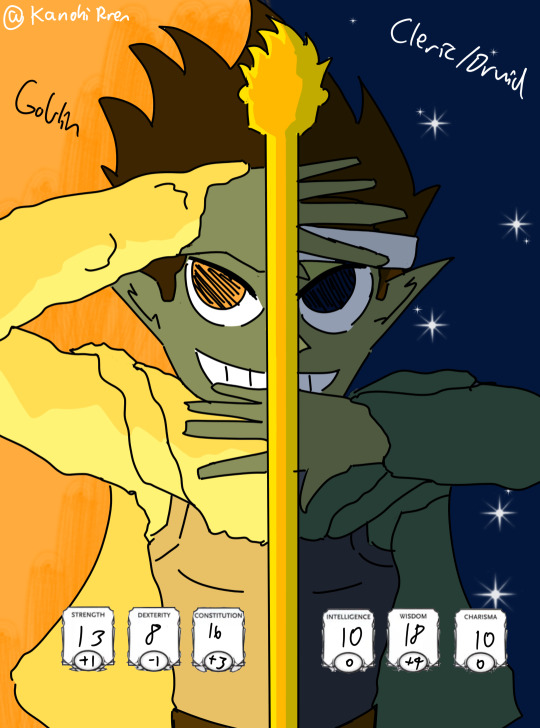
Class: Druid (Circle of Dreams) 7, Cleric (Life Domain) 1
Race: Goblin
Base Ability Scores:
Str 13 (+1)
Dex 8, (-1)
Con 15 (+2) +1 from race = 16 (+3)
Int 10 (+0)
Wis 15 (+2) +2 from race = 17 (+3)
Cha 10 (+0)
Background: Guild Artisan (builder/carpenter)
As a Wisdom based caster, Bdubs will of course be prioritizing his Wisdom stat. The Strength score is necessary to wear heavy armour, which he gets from his cleric dip. If the whole “druids don’t wear metal” thing is an issue, just flavour it as being made of something else.
I built Bdubs to be an extremely good healer outside of combat, but in combat he will probably struggle to match people in damage (which is okay! That’s the other party member’s job)
Before we get into the class features, we’ll start with the goblin race features:
Darkvision 60ft.
Fey ancestry (advantage on saving throws vs being charmed)
Fury of the Small (pump extra damage equal to proficiency bonus onto attacks or spells) “I AM NOT SHORT I AM VERY TALL”
Nimble Escape: disengage or hide as a bonus action.
And the Guild Artisan background features:
Skill proficiencies: Insight and Persuasion
Guild Membership: The guild has your back
First, we start with a level in Cleric. At level 1, you gain:
Proficiency in light and medium armour and shields.
Proficiency in simple weapons
Proficiency in Wisdom and Charisma saving throws
Skill proficiencies: Religion, Medicine (obvious choices for a cleric)
Three cantrips: Guidance, Light, Toll the Dead
1st lvl Cleric spells: Clerics are prepared casters, you can swap out spells after a long rest, but Life Domain Clerics automatically have Bless and Cure Wounds prepared. Suggested spells would be Healing Word, Sanctuary, Shield of Faith and Guiding Bolt
Subclass: Life Domain
Life Domain grants:
Disciple of Life feature. Your healing spells heal an extra 2 + the spell’s level HP (the main reason for this 1 lvl dip. The extra healing scales with the spell level, not cleric level, so there’s no need for extra levels in this class)
Proficiency in Heavy Armour (allows you to wear chain mail)
As for his deity, Bdubs of course worships himself as he established himself as a god in the hermitcraft x empires crossover.
We only take one level of Cleric; the rest is now all druid. If you’re worried about level progression, it may be more convenient to start with druid and only dip into cleric after 5 levels. The main difference would be different saving throw proficiencies, but it’s not a big deal. The biggest reason to start Cleric is for the Disciple of Life feature to buff all your healing spells.
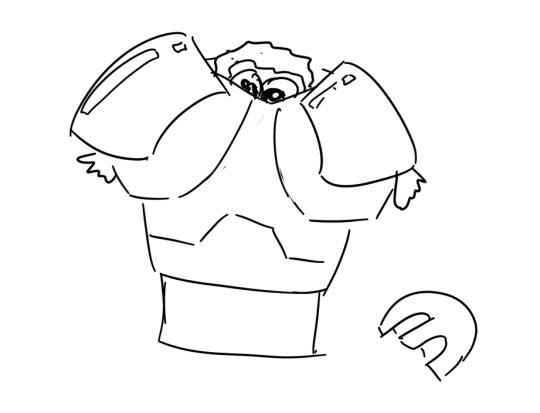
At 2nd level, we begin our journey into Druid.
At level 1, a Druid gains:
Druidic: secret language so that when you go “AUAAUAHGGGHUGETHO” it’s actually words
Two cantrips: Druidcraft, Primal Savagery
1st lvl Druid spells: Druids are also prepared casters like Clerics, but the important spell is to take GOODBERRY.
Bdubs is a druid because he is of course a moss enjoyer.
Goodberry synergises extremely well with Disciple of Life. Normally, Goodberry creates 10 berries that heal 1 hp each. Disciple of Life boosts the effect of healing spells by 2 + the spell level (goodberry is 1st lvl), so each Goodberry instead heals 4 HP for a total of 40 HP with a 1st lvl spell at lvl 2.

At 3rd level, we gain a second Druid level, which grants:
Wildshape
Subclass: Circle of Dreams
Circle of dreams grants:
Balm of the Summer Court, grants you a pool of d6s to heal party members with, which is even more healing for your party. (Does not synergise with Disciple of Life as it is not a spell)
At 4th level, we gain a third Druid level, which grants:
2nd level spells. Suggested spells: Healing Spirit (multiple instances of healing, strong synergy with Disciple of Life), Spike Growth (hurty moss)
Additional Cantrip: Anything works, suggested: Infestation
At 5th level, we gain a fourth Druid level, which grants:
Ability Score Improvement OR Feat. If you don’t use feats, add +1 to Wisdom and +1 to Strength.
Feat: Fey Wanderer. Grants a +1 to Wisdom (bumps it up to 18 for a +4 modifier) and the Misty Step spell, which is handy for running away from danger like Bdubs often does (“AAAUHGGHAAGH *disappears in a puff of smoke”).
Improved wildshape
At 6th level, we gain a fifth Druid level, which grants:
3rd level spells. Suggested spells: Conjure Animals (HORSES!), Plant Growth (MOSS) or Speak with Plants (SENTIENT MOSS)
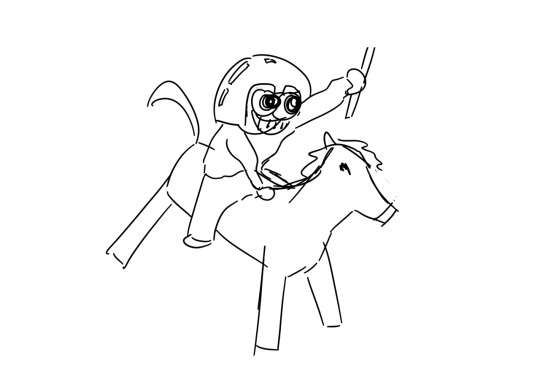
At 7th level, we gain a sixth Druid level, which grants:
Subclass feature: Hearth of Moonlight and Shadow. Basically, allows you to obscure an area to make a safe space for your party to take a rest in (gotta shreep!)
At 8th level, we take our seventh Druid level, which grants:
4th level spells. Suggested spells: Polymorph, Confusion
Summary:
Final Stats:
Str 13 (+1)
Dex 8 (-1)
Con 16 (+3)
Int 10 (+0)
Wis 18 (+4)
Cha 10 (+0)
Feat: Fey Wanderer
Cantrips: Druidcraft, Primal Savagery, Guidance, Light, Toll the Dead, Infestation
Wildshape for up to 3 hours
1st to 4th level spells: Prepare up to 5 Cleric spells and 11 Druid spells.
And that’s it! The result is a druid with extremely powerful healing abilities but who may also turn around and bite you or summon a stampede of horses on you. Perfect for Bdubs!
#trafficblr#traffic dnd#bdubs fanart#hermitcraft fanart#life series fanart#dungeons and dragons#my art
8 notes
·
View notes
Text

Martin X-23A P.R.I.M.E. (Precision Reentry Including Maneuvering reEntry) (SV-5D)
“The ultimate in travel between earth and space, of course, would be a vehicle capable of flying into space and returning on its own.
This would eliminate the need for launching by rockets, a costly business. However, a ship designed to do at least half of the job now has reached an advanced developmental stage.

It’s the Martin Co’s SV-5, a wingless V-shaped space plane that looks, at different angles, like an elongated teardrop or streamlined flat-iron without a handle. The Air Force has announced that the ships, scaled down from the actual size envisioned for them, will be used to explore the effects of hypersonic speeds—of about 17,000 mph—on flights from space down through the earth’s atmosphere. The test vehicles, of course will be unmanned."
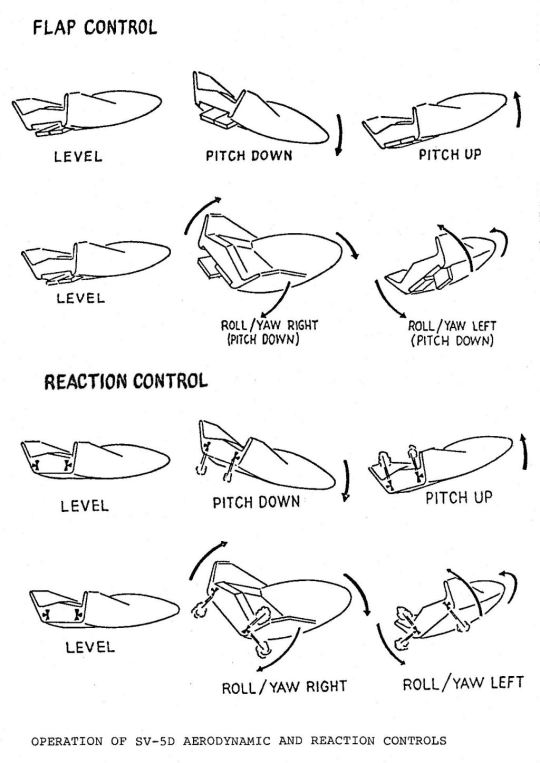
"The PRIME project was the second part of the Spacecraft Technology and Advanced Re-entry Tests (START) program. It had the dual objective of testing advances in space hardware and further exploring the development of manned and unmanned lifting body vehicles. On a typical flight, the unmanned SV-5D was launched by an Atlas booster from Vandenberg Air Force Base, Calif. At the high point in its flight path, the Atlas pitched downward while its rocket continued accelerating it to speeds nearly as great as those of the spacecraft re-entering the earth's atmosphere. The lifting body's inertial guidance system directed it to a preselected recovery point. Three PRIME test flights were made, the first on Dec. 21, 1966, and the last on April 19, 1967. A scheduled fourth flight was cancelled due to successes of the previous tests."
Artwork by Frank DiPietro
Date: 1965
Mike Acs's Collection: link
Ed Dempsey's collection: link
source
#Martin X-23#X-23#SV-5#SV-5D#lifting body#NASA#concept art#re-entry#reentry#1965#Martin SV-5D#Martin X-23 PRIME#my post
38 notes
·
View notes
Text
Warning: some unmarked spoilers for most official 5e campaigns below. Also, long post written over several days with resultant tonal shifts.
If, like me, you find yourself terminally dissatisfied by D&D 5e (and horrified by OneD&D or whatever they're calling it now) but still wanting to run its major published adventures because otherwise what did you *buy them all for*, here are some suggestions! I'm going to steer away from stuff that's too straightforwardly a retroclone or "D&D but with X rule changed," because that's boring. For each adventure, I will explain what I think a good adaptation needs, provide a "played-straight option" which is a system to pretty much directly port the adventure into, only requiring some rules conversion and maybe minor setting flavour, and an "offbeat option," which is going to require major narrative changes and often shift the entire genre. With two exceptions I'm going to recommend games I've played or at least read many times over; if you know of other things that would work then feel free to comment or reblog with them!
So, in chronological order of the adventures I own...
Lost Mines of Phandelver
The important thing about LMoP is that it's a starter adventure, taking characters who start off as basically nobodies but who have either personal connections or moral ties that draw them into a pretty morally straightforward conflict with several groups of bad people working on behalf of a single villain. In the process, it shows off a bit of travel and exploration, a bit of social activity in phandelver itself (mainly of the obtain-quest-hooks variety) and a lot of combat, easing people into the game.
Played-Straight: 24BLUE
A solid but simple old-school fantasy-oriented but setting-agnostic hack of 2400 with light, intuitive but flavourful rules for creating characters and monsters and good guidance on how to convert over from other systems. It's also cheap as chips ($3) and 4 pages long, meaning it puts very little work on a new gm. Frankly, I think flexible and rules-lite systems are the best way to get people into rpgs, so this is ideal. Also, it has something of a tendency to depower more powerful monsters in conversion which might be an issue with larger-scale games but really isn't with the 1-5 scale of Phandelver. Just maybe fudge a bit to preserve the sense of threat with the dragon.
https://deep-light-games.itch.io/24blue
Offbeat: All that I Am
So Phandelver's a game about good-hearted nobodies rising to defeat evil, right? But they're good-hearted nobodies with magic and sword-skills. What if they kept the drive but lost the power? What terrible price might ordinary folks pay to defeat an evil which they are unequipped to face? Also cheap (PWYW, $11.36 recommended) and also simple (albeit less so,) All That I Am is a game about people who have made a pact with a demon and slowly realize that this was Probably A Mistake. It has a really cool basic mechanic based on tossing coins into a magic circle - not one for online play! - and a very flavourful list of demons to mess about with. It's naturally darker in tone than D&D, which is going to affect your story through play, but the setting could honestly probably go unchanged and the only plot alteration you might want to make is reshuffling the adventure so that it starts in Phandalin and goes 1. Get bothered by Redbrands; 2. MAKE PACT TO DEFEAT THEM (going into wilderness to conduct the ritual in secret); 3. Get ambushed by Goblins on way back from wilderness; 4. Return to phandalin and go from there, rather than the standard goblin lead-in. If you wanted to change the setting to the more Renaissance Europe default assumption of ATIA, you could easily enough make the Goblins into bandits or wicked faeries and Nezznar into a human schemer.
https://www.drivethrurpg.com/m/product/271265
Honourable Mentions: Warhammer Fantasy Roleplay, Burning Wheel if that's your thing
Princes of the Apocalypse
I know a lot of people don't like PotA. Cards on the table: it's my favourite 5e adventure, and I've run it once already. It is, to me, the archetypal D&D story, which made it really hard to pick alternatives which aren't just branches of D&D. It's got a fairly balanced mix of combat, social and exploration/investigation elements through which the characters uncover the works of four tactically diverse elemental cults which are often remarkably subversive of typical expectations of their element, led by well-realized and psychologically interesting villains, all of which both tie together into a single core and branch out into loads of loosely related side quests and plot threads.
Played-Straight: Warhammer Fantasy Roleplay
Four divine cults tied to a single powerful evil force, you say? Warhammer's Moorcockian forces of Chaos fit pretty much perfectly. You could keep the elemental theming, even, with the cults venerating the Four Gods in elemental aspect, or switch elementals for daemons and just retain the front organisations. I recommend associating Tzeentch (god of change and magic) with the fire druids, Khorne (god of honour and violence) with the earth monks, Slaanesh (god of pride and excess) with the air knights and Nurgle (god of health and sickness, who already has a substantial maritime followinh) with the water bandits. True, the game might be a bit more gory and lethal thanks to random injury tables and lower power levels, but if you're playing the 4th edition by the book it probably won't be enough to shift the tone of the adventure especially if you're generous with the Fate and Resilience points. It supports social play, particularly player character psychology, very well, and has some simple but workable exploration rules on a similar level to D&D's (but with a better, more narrative-focussed random encounter table!) Additionally, the adventure doesn't have any major "pay X gold to get some benefit" moments, meaning that warhammer characters (who might well start play as a poor refuse collector or peasant farmer due to random character generation) won't find they're gated out of elements by different expectations of character wealth compared to D&D.
https://cubicle7games.com/our-games/warhammer-fantasy-roleplay
Offbeat: Avatar Legends
OK, so this is one of the ones I haven't played, though I hear good things. I'm recommending it on the strength of the setting, because get this: elements.
More seriously, a major theme in the original AtLA (haven't watched Korra) is "the gang show up somewhere where people have some cool powers/tech/fighting style but there's also Something Creepy and Bad Going On. You could bring the elemental powers of the cults more into the foreground, making them organisations of highly trained benders dominating an isolated region and connected - this being the element that remains a secret - via their mutual corruption by a powerful, trapped dark spirit (replacing the Elder Elemental Eye). The fact that there's an air cult means you'd probably need to set it before the Air Nomad Genocide unless the air knights being a special unique school of different airbenders was a plot point.
https://magpiegames.com/pages/avatarrpg
Honourable Mentions: Worlds Without Number, Burning Wheel, Pendragon, Rennaissance
Out of the Abyss
My favourite adventure that I've never run, Out of the Abyss' key feature is survival and exploration, followed by power scaling. The characters are going to start off nearly naked in an alien environment and end up killing several demon lords, if they don't starve or go mad first, and it's important that a game be able to capture that.
Played-Straight: 18XX Dreams
Sort of played straight. Another 2400 hack, this one works if you accept that the underdark of OotA was set up as a dreamlike space inspired by Alice in Wonderland, because it's a setting built entirely around the dreamworld. Who trapped the characters in the shadowy world of nightmare which is our underdark here? Drawing on Lovecraft's Dreamlands, maybe it was the slaving Men of Leng rather than the original module's drow, or maybe some wicked drowesque fairies will do. At any rate, from there you can pretty much run the thing straight from the module, just with a bit more creative license. The game's player powers might seem excessive at first, but they're really just exploration-oriented where D&D's are often combat-oriented; you'll quickly get used to working around them and if you don't it's an easy game and easily hacked. (Incidentally, Dreams requires a 'waking world character' as a bass for which I recommend you use the compatible 24BLUE system mentioned above. You could also pull advancement from that system, which you'll want to do if you aren't going to emphasise the final ritual as the only way to defeat the demons).
https://deep-light-games.itch.io/18xx-dreams
Offbeat: FIST
Kidnapped by esoteric Nazi explorers, our band of late-80s urban fantasy action hero mercs are now trapped in the Hollow Earth! Will their scavenged gear and hard-won skills be sufficient to allow them to escape and/or best both the pursuing fash and the terrible cthonic deities they have unleashed in their excavations?
FIST is a fast-paced near-modern setting game with one of the most enjoyable and simple combat systems I've seen, which should make the near-endless random encounters a bit more breezy. It's core ethos is that the characters are an overmatched A-team style force (often with surprisingly little gear) who are going to have to lie, cheat, steal and McGyver their way to survival let alone victory, which fits *perfectly* with early OOtA. The alternating zaniness and horror also mesh really well, though you might need to port madness mechanics over. And yes, it already has basic stats for demons of various degrees of power!
https://claymorerpgs.itch.io/fist
Honourable Mention: Warhammer Fantasy Roleplay
Curse of Strahd
Curse of Strahd is a game that I've run twice,neither by the book, and my key takeaway is that it really feels like it should never have been made in 5e. A great, interesting horror story is just broken up by having to have a set-piece fight with a monster every half an hour. That said, what's important to adapt is clearly the sense of dread and the social webs between characters, as well as the power differential between heroes and villains that makes the latter scary.
Played-Straight: Thirsty Sword Lesbians
Strahd is an abusive, manipulative prick who wants to toy with the PCs' emotions more than kill them. Thirsty Sword Lesbians is a game where emotional breakdowns generally replace death (which makes it feel a lot less like the GM is just playing the genius villain as an idiot) and defeating abusive pricks is a big part of the power fantasy. Even if it doesn't initially sound like your thing - it didn't to me - I *seriously* recommend giving it a look. It's an awesome game. No setting or adventure change is really required, but the focus on having action and fights be less a constant than something that happens when and where it's emotionally impactful gives you permission to cut some of the needless violence in favour of more creeping gothic horror if you want to. Also, it has to be said that having rules around romance and relationships is probably a good thing for the game sometimes affectionately known as "5e's dating sim".
https://evilhat.com/product/thirsty-sword-lesbians/
Offbeat: Old World of Darkness (Hunters Hunted+Sorcerer+Ghost Hunters+Mage: Victorian Age)
This was the idea that made me write this post: a Victorian factory town in the hills outside Manchester where the characters become trapped, not by the physical bounds of mist (or not *only* by them) but by ties of class and social obligation, forcing them to remain in the twisted demesne of the local industrialist, a man who is more than he seems (a vampire? An utterly corrupt and evil mage called a Nephandus? World of Darkness has lots of options.) Barovia is shrunk in scale to the town of Barrowdale and its immediate rural environs, creating claustrophobia without breaching the lower-fantasy constraints by having the Strahd equivalent hop on his magic horse. World of Darkness has a modestly complex system, but it's a little lighter than D&D especially for the relatively normal mortals the characters will be playing. They might have a spiritualist medium, a Sorcerer or Psychic capable of a couple of tricks or perhaps somebody whose True Faith in God can protect against the unholy, but for the most part they'll be relying on mundane skills as they uncover the town's shadowier side. I love the idea of the Keepers of the Feather as a group of socialist agitators, the Baron's Vallaki as a disjointed and ineffectual trade union or Argynvostholt as the cellar network left behind by the families whose estates were cleared to build the new rows of red-brick tenements. Just one thing: please don't have Strahd be Eastern European in this set-up, the vampiric foreigner invading British soil is an unpleasant trope.
Rules for vampire powers so you don't have to buy a whole vampire book as well are to be found here:https://saligia.fandom.com/wiki/Saligia_Wikia - use the White Wolf Wiki for guidance on what you're looking for.
https://www.drivethrurpg.com/m/product/401413
https://www.drivethrurpg.com/m/product/114261
https://www.drivethrurpg.com/m/product/368774
https://www.drivethrurpg.com/m/product/412531
Honourable Mentions: Dread, Dark Age Cthulhu
Storm King's Thunder
SKT is another story reliant on power scaling to make its premise work. It has a massive, almost sandbox-y setting in which the characters gradually pick up plot threads explaining why bad things are happening around them, fight their way through one of several dungeons and then use their trophy from that to unlock the finale in which they go head-to-head with giants, a kraken and a dragon in pretty short order. Honestly, I don't like it as an adventure, but if you're wanting to run it you're going to want at least some support for interesting travel and a solid power scale that will allow some pretty big fights at the high end.
Played-Straight: Worlds Without Number
It may only have 10 levels (sort of), but its lack of bounded accuracy means this fantasy game of wandering experts, mages, warriors and adventurers scales impressively into the higher of those. It's travel rules maintain the interesting elements of resource management whilst being more streamlined than 5e's. Also, and this is a side-note, characters are very customizable with everybody getting a couple of free feat-equivalents. It's very solid and entirely system-agnostic, meaning you can use the great big highly-detailed map and chapter of encounters which are without a doubt the best part of SKT.
https://www.drivethrurpg.com/m/product/348809
Offbeat: Traveller
Of course if you *wanted* to adapt the map...
Traveller is a sci-fi game, known for extensive and random character generation but which also likes big hex grids! Seriously, look at this thing.
It is pretty setting-agnostic, meaning you can create your own sci-fi setting (and map!) that fits in equivalents to the adventure elements (some people have even made historical or fantasy hacks, for which check out Mercator or Halberts). It has extensive rules for travel, of course, and also modular rules for just about everything else so that whether your characters want to be merchants or mercenaries you can patch in more complex rules to serve that need. In what is essentially a massive sandbox with loose themes that coalesce into a plot at the end, that works really well, and you can still have the big threats that the adventure relies on in the form of enormous alien battleships. I think I'd be using the K'Kree, murderous centaur like vegetarian absolutists, as my giants if running in the official Traveller setting of the Third Imperium golden age, but honestly any of humaniti's alien neighbours could work if they turned hostile.
There are a lot of editions of traveller, but the 2nd edition book by Mongoose is a great modern entry point.
https://www.mongoosepublishing.com/collections/traveller-rpgs
Honourable Mention: Forbidden Lands
Tomb of Annihilation
ToA, the last of these I've run, is to my mind a much better hexcrawler than SKT and indeed 5e's best pure exploration adventure. The PCs have a goal, a timer, and an immense, confusing, murderous obstacle in the way in the form of the jungles of Chult. Once they beat that, it's time for a different sort of crawl as they explore massive puzzle dungeons. A game that works for this needs to be good at both map-scale and site-scale exploration, not just in the evocation of travel in the narrative but also the nitty-gritty survival details of whether you contracted throat leeches today. Oh, and it needs to be a setting that allows for big powerful mass-influence magic or something and for resurrection so the death curse plot point can be set up.
Played-Straight: Forbidden Lands
A game *about* exploring a hex map, with a die-based supply system that reduces bookkeeping to a minimum whilst keeping resource tracking central, detailed travel and camp actions and a slightly low-fantasy tone that fits well with how I conceive ToA. Nothing here would stop you using the official setting, though some of the assumptions about D&D magic it makes might need tweaking.
https://freeleaguepublishing.com/en/games/forbidden-lands/
Offbeat: Eclipse Phase
In the mid-distance future, the shock of an AI uprising that decimated humanity has led us to flee earth, embrace transhumanism and conquer death through the practice of resleeving into new bodies. 10 years after "the Fall," sapients - humans, uplifted animals and limited AIs - live throughout the solar system and, via a series of weird teleport gates, beyond. But now (this plot proposes) something in the outer reaches of the solar system is broadcasting a rare strain of the ai-created Exsurgent Virus, which twists its sufferers into monsters - this one affecting not active sleeves, but backups. Whenever somebody resleeves- like, say, if they broadcast their mind into a new body on the edge of the solar system to find out what's going on - they have limited time left before they become an abomination. EP has pretty solid survival rules, greatly expedited by sci-fi technology, and a system of mental stress that'd fit ToA's horror elements well, but I won't pretend it wouldn't be a faff to convert. It doesn't have much support for something like hexcrawl, though it'd be easy enough to set up a map of outer system habs in a given area of space, and its characters tend to be hypercompetent in a way that could reduce the sense of threat. With the themes of death and resurrection, terrible elder entities and horror embedded in a way that not many sci-fi rpgs do, though, I think it'd be worth it if you're willing to deal with some crunch. All of the big books for it are also available for FREE from the publishers, though I recommend supporting them - they're awesome people doing good work.
https://robboyle.info/#eclipse-phase-pdfs
Honourable Mention: Warhammer Fantasy Roleplay
Ghosts of Saltmarsh
Other than OotA, this is probably the adventure (I mean, anthology I guess but it's an anthology with some very strong connective tissue) that I'd most like to run some day. The thing Saltmarsh needs most is of course good sailing rules or the ability to adapt the ones in the book naturally, but a functioning mass combat system for the attack on the sahaguin lair would also be helpful, as would anything making it easier to run a horror game.
Played-Straight: Cthulhu Dark Ages+Corsairs of Cthulhu
One of them's set in the 1000s, the other in the 1700s, but between them that basically averages out to the medieval mishmash that is D&D and provides rules for anything you might want. The dark, gritty human-scale tone (well-suited to Greyhawk) can be made low fantasy by using some of the 'folk' - read non-sanity-blasting - magic found in Dark Ages and from there you can pretty much run the setting straight, either in the original setting (you'll need to homebrew some rules for nonhuman species) or in our own (removing non-monstrous nonhumans altogether). Call of Cthulhu's rules in general bring in a system for character sanity that's very well suited to the frequent horror of Saltmarsh - there's even an asylum already in one of the adventures should your character go mad! - whilst Dark Ages brings some detailed, brutal rules for combat with armour and swords and Corsairs, in addition to ships, adds the blackpowder weaponry that always felt it was missing from Saltmarsh. You should probably keep using the random ship events and Encounters in the 5e book, but if you just keep a comparative list of dice difficulties in the two games they won't be hard to convert even on the fly. Honestly, the big issue here is price, because you're going to need the core rules and two supplements to get started. If that's unfeasible, grab the quick-start or starter set rules and corsairs and then send me a message; I'll give you the relevant extracts from the dark ages rules that I think would help. You can find rules for converting between D20 and CoC's D100 systems online, but honestly the game's standard array of monsters should be fine for representing most stuff in Saltmarsh.
https://www.drivethrurpg.com/m/product/388056
https://www.chaosium.com/cthulhu-dark-ages-3rd-edition-hardcover/
https://www.chaosium.com/call-of-cthulhu-keeper-rulebook-hardcover/
Offbeat: Exalted
OK, hear me out: exalted is a game (d10 system similar to world of darkness but, weirdly, much better social interaction rules) about being reborn, hunted godlings in an almost ridiculously high-fantasy setting, doing incredible things with an array of powers and skills that take competence porn to and beyond the levels of epic D&D 3.5. The world they live in, however, can be as dark and desperate as it is strange and wonderful, and does have a fair number of Normal People who would live in a place like Saltmarsh. That setting also makes the appearance of random island encounters and magical storms popping up out of nowhere feel a lot more natural than it does in Greyhawk. Most importantly, the core game has not only rules for mass combat and sailing, but specific powers to make specialist characters supernaturally good at those things - six pages of options for sailing alone. It might lose some of the classic Saltmarsh horror, and you might want to raise the crew of the first pirate ship to more reasonable levels because even starting exalted will punch through 13 minor enemies with ease, but trust me: it's worth it for how cool it will make your pcs feel and how many rich exploration opportunities will open up to them with increased resilience to harm.
https://www.drivethrurpg.com/m/product/162759
Descent into Avernus
Most noted for a wide gap between character level and apparent threat, though that's really just illustrative of 5e's design philosophy, for me DiA's main 'deal' is tonal diversity, sometimes to the point of whiplash. You go from morally-ambiguous intrigue in a dark den of crime and iniquity to similar except now in hell and with cultists to Brütäl Mäd Mäx Räcës, aided by a flying golden elephant on a quest to redeem a fallen angel. At the same time, the story isn't really meant to be zany in the same way as something like OotA, so the key is probably finding a system that doesn't enforce any particular tone rather than one that enforces tonal dissonance within scenes like Dreams. Given the critical choices between fighting and negotiating the module presents at points, it's also important that the system chosen not make one of those dramatically better than the other.
Played-Straight: Between the Skies
Using a very loose, modular system - it literally lets you choose your dice system! - Between the Skies is basically a collection of systems for inspiration generation to service a plane- or world-hopping campaign. It makes characters varying from the mundane to the weird (should you want to run DiA as the planescape game it cries out to be) interesting through a lifepath generation system which is a bit more than the usual; how often do you find the option to die in character generation *but keep playing that character?* Then it provides guidance for travel, vessels (in a way that'd work quite neatly with the Infernal war machines) and adventure across the planes with a philosophy of maximising the role of the GM as opposed to the system. Its combat system works mostly narratively rather than relying on dice, but still allows a good deal of complexity where needed: you can zoom into or out of combat scenes according to how necessary they are to the plot, either resolving them quickly without losing danger, useful for many of Descent's random encounters, or running more detailed fights. It is ultimately a toolbox game, and will reward a gm who's also willing to be a bit of a designer.
Offbeat: Dark Heresy
A story in which characters begin investigating corruption amongst mortal powers and then delve into literal hell might be an excellent fit for a mid-high level game of the classic Warhammer 40k game of inquisitorial agents rooting out heresy in the grim dark future. Baldur's gate can easily be a significant garrison world, Elturel its Daemon World neighbour from which the characters venture into the Eye of Terror or Great Rift in search of a rumoured way to "redeem" (read: bring back to the Imperium, itself a theofascist nightmare state) a Daemon Primarch, one of the lost children of the Emperor. Given this is 40k, and that Dark Heresy is full of rules for corruption and horrible death, it's likely to end less hopefully than DiA typically does, but you never know!
https://www.drivethrurpg.com/m/product/65872
Honourable Mentions: Exalted, Thirsty Sword Lesbians
Rime of the Frostmaiden
It has been well-noted by now that RotF is quite a good horror story and quite a poor D&D adventure. Honestly, I think even as horror it's a bit of a tonal mess, but it definitely has some strong elements there which are weakened by the characters throwing around resurrection magic and fireballs as the solution to all of their problems. This isn't to say they aren't allowed fireballs - it's pretty solidly a fantasy story - but that the game needs to be about problem solving and fear first and foremost, with of course the ever-present threat of the elements.
Played-Straight: Dread
One for the confident improvisers, dread has a single mechanic: if a character does something they aren't confidently capable of, they pull from a Jenga tower. If they make the pull, they succeed or avoid a threat; if they chicken out, something bad happens; if the tower topples, something very bad happens. Normally this removes them from play; for a longer campaign I might have the first topple lead to the character's secret (a very fun part of RotF is that every character is hiding something, often something nightmarish like an alien parasite growing inside them) being revealed and the second killing them/driving them mad/leading them to flee Icewind Dale and return home. Other than this, the major adaptation would be working out how to narratively implement PC archetypes. I think you can be generous with this - for a barbarian PC, they might be able to crush obstacles or slaughter minor foes without a pull, for example, whilst a water wizard could melt large areas of ice or breathe below the surface of a frozen lake. In short, step away from 5e's highly-defined abilities, let PCs do anything that makes sense and focus on threatening them with the things they *can't* control, which is likely to be a lot. When fights, the weather, stress and magic all threaten a single, communal resource, you'll find the kind of tension and caution the module seems to expect much easier to evoke.
https://dreadthegame.wordpress.com/about-dread-the-game/
Offbeat: Doctor Who: Adventures in Space
This is the other game I've not played (though it's designed by Cubicle 7, whose work I trust implicitly). I'm recommending it mostly for the narrative, because it seems to lend itself so well: the doctor and companions find themselves drawn to an 18th-19th century Russian arctic Island/planetary colony where a powerful cosmic being has brought down eternal winter, the cybermen are building a new cyber-king and an ancient alien city lies frozen in ice. You probably need to think of an actual reason why Auril's frozen Ten Towns, possibly something to do with the fallen city, because your resolution is going to be a result of investigation and clever plans rather than fighting, so be willing to put in the work there. On the easier side, the time travel element that can appear at the end won't be as sudden and jarring in a setting predicated on it!
Quickfire Round of Books I Don't Own
Dragon Heist: Dusk City Outlaws/Fiasco/Royal Blood
Dungeon of the Mad Mage: Advanced Fighting Fantasy
Wild Beyond the Witchlight: Changeling the Dreaming
Tyranny of Dragons: HârnMaster/Pendragon
Candlekeep Mysteries: Amber Diceless/Rennaissance
Radiant Citaedel: Between the Skies/Mage: the Ascension
So there it is! My challenge to you is as follows: if you were considering starting a new 5e campaign with one of these campaigns, expose your group to something new and try one of these instead. Let's break WotC's near-monopoly on this hobby, because they sure as hell don't deserve it. If you do do anything with any of these (or, as I say, if you have better ideas) please let me know!
#ttrpg community#dungeons & dragons#dnd 5e#d&d 5e#5e#wizards of the coast#new rpg#not going to tag all the games I've suggested because their communities already know what they work for#open game license#ogl#wotc
15 notes
·
View notes